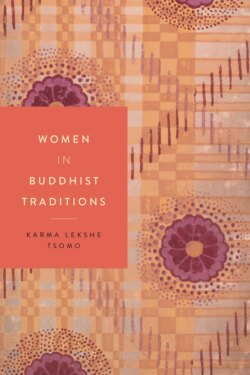Читать книгу Women in Buddhist Traditions - Karma Lekshe Tsomo - Страница 15
На сайте Литреса книга снята с продажи.
The Prediction of Decline
ОглавлениеIn addition to the matter of the eight weighty rules, a number of Buddhist texts record a prediction by the Buddha that the ordination of nuns would decrease the duration of pure Buddhism to five hundred years. As noted above, in the Madhyama-āgama, the Buddha is quoted as saying that, if women were permitted to live the homeless life, the teachings would not endure. This utterance indicates a concern that homeless wandering would pose a danger to the nuns’ celibacy and safety. Later in the passage, the Buddha says, “Ānanda, if in this right teaching and discipline women had not obtained the leaving of the household out of faith, becoming homeless to train in the path, then this right teaching would have remained for a thousand years.”45 This utterance lends itself to quite a different interpretation than the former: it becomes a prediction that the Dharma will disappear as a result of women’s admission to the monastic order. However, since women subsequently did not live a literally homeless life but instead settled in urban areas, the danger to both the nuns and the Buddhist teachings was successfully averted.46 Now, more than 2,500 years later, the Buddhist teachings are still alive and well, despite women’s admission to the saṅgha. Comparative philological analysis makes it clear that variations in the texts express different attitudes toward women. It is difficult to assess whether these different attitudes reflect the intentions of those responsible for recounting the teachings or reflect attitudes prevalent in society at the time. Regardless, it is likely that the attitudes toward women expressed in the texts subsequently influenced the ways in which women, their character, and their spiritual capabilities were regarded in societies for generations to come.
In comparing parallel versions of an account of the teachings of the monk named Nandaka in the Pāli canon, Anālayo points out significant differences in gender relations. These include differences in the way nuns are introduced (for example, by mentioning their fame and greatness), the degree of deference indicated in the postures they adopt, whether the Buddha spontaneously teaches the nuns, whether the Buddha replies to a nun’s request, the type of response he makes, the degree of thoughtfulness with which he makes them, the degree of respect that nuns show to monks, descriptions of the nuns’ insights and attainments, and other markers.47 Such indicators convey important information about social customs at the time, about what was considered appropriate or inappropriate conduct for monastics, and also about attitudes toward women in general. Moreover, when Anālayo compares parallel versions of the story of Nandaka delivering a discourse to the community of nuns in the Pāli canon, he finds certain discrepancies, both subtle and significant, among the accounts. Some early accounts seem to express a greater respect for nuns and portray them in a more favorable light than others. Taken together, these discrepancies give the impression that attitudes of the monks toward the capabilities and attainments of nuns may have not only changed over time but also differed among redactors and commentators. In other words, whether a text speaks of thirteen outstanding nuns or five hundred fully awakened nuns may reflect the attitudes and opinions of those who recited and thus transmitted the texts orally for several hundred years before they were committed to writing.48 Internal inconsistencies among the texts, even among different redactions of the Pāli texts, seem to indicate that changes occurred over time that may reflect the preferences of the reciters. In reading the Nandakovāda Sutta, Anālayo concludes that less favorable attitudes toward nuns in later texts may have influenced certain Theravāda texts. This conclusion challenges a prevalent assumption that the Theravāda texts are more misogynistic and that the Mahāyāna texts are more women friendly.49
There are also inconsistencies in accounts between Mahāprajāpatī’s initially joyful acceptance of the weighty rules and her later plea to the Buddha to revoke the rule that establishes the seniority of all bhikkhus, no matter how junior, to all bhikkhunīs, no matter how senior.50 Anālayo suggests that the rules were an attempt to keep the nuns under control, given the uncertain future of the Buddhist saṅgha after the Buddha’s passing, and reflected the patriarchal nature of Indian society in that day.51
